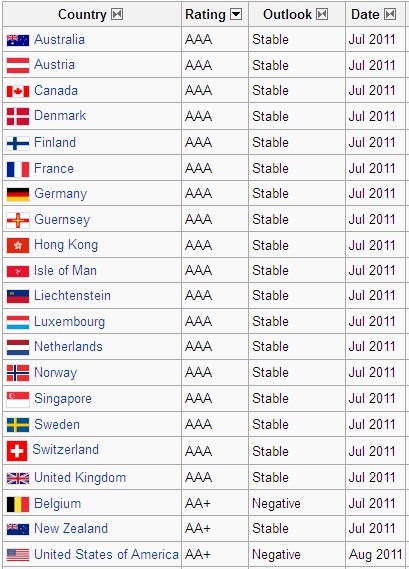What will the week after a credit downgrade bring?
Posted By RichC on August 7, 2011
 Panic … it is going to be the big issue for financial markets come Monday morning. It won’t be pretty.
Panic … it is going to be the big issue for financial markets come Monday morning. It won’t be pretty.
Is there really a difference between where we were last week (after the debt ceiling increase) and where we will be on Monday morning? No, not really, but unfortunately Standard and Poor’s downgrade (PDF) of the United States is the perception which is going to be reality.
It is far too easy to point fingers at politicians who have borrowed and spent our way into a mess, but Americans as a whole have emulated the government with their own borrowing and spending and living beyond their means as well. Adjustments are going to require everyone to tighten their bootstraps to get spending and debt under control. The two points that came out of the “five pillars” S&P looks at when downgrading credit (politics, the actual economy, fiscal and monetary policy and externalities), was that politicians aren’t working together to address the problem and that the policy legislation passed doesn’t go far enough to address U.S. debt.
These things being said, panic is going to be the biggest issue with the US credit downgrade. The reality is that US Treasuries are still considered very safe, in fact in my judgment far safer than many on the list below which have triple-A ratings. As a post in the Weekend WSJ pointed out, do you really think a Luxemburg bond is safer than the United States? I think not. If the world economies collapse, I’d rather both be in the US and own US treasuries. As Mark Gongloff pointed out in a Q&A:
Q: What’s the difference between AAA and AA+? That doesn’t sound so bad.
A: It’s not so bad — and there’s not much difference. Technically, AA+ is considered “high grade” credit, while AAA is “prime.” The likelihood of getting paid back by a AA+ credit is considered “very strong,” while a AAA credit’s likelihood of paying you back is “extremely strong.” See the difference? Me neither. And the U.S. is a special case, given its status as the world’s largest economy and printer of the world’s reserve currency. If your personal credit score falls, then you will almost certainly have to pay more to borrow. The U.S. can get away with a slight credit-rating downgrade without having to pay more to borrow. In fact, many other large, developed economies, including Japan, Canada and Australia, have lost AAA ratings in the past and not had to pay more to borrow in the long run.
The S&P will monitor the U.S. for about six to 24 months to see whether its fiscal position deteriorates further or if political gridlock gets worse. John Chambers, the group’s managing director, said Sunday it would take stabilization of the debt as a share of the economy to determine the direction of S&P’s rating, and it’s no easy task to get it to rise.
"If history is a guide, it could take a while. We’ve had five governments that lost their AAA that got it back. The amount of time that it took for those five range from nine years to 18 years," he told ABC’s "This Week."

Comments